A module titled “Profitability Analysis: Coconut Sap Sugar Production,” published by PCARRD explains the process of producing coconut sap sugar.
The module was based on information adopted by PCARRD from the Philippine Coconut Authority. The production process is ideal in the farm level and can produce a high-value product from the sap of the coconut inflorescence. It involves a natural process of heat evaporation to convert liquid sap to solid form of sugar granules.
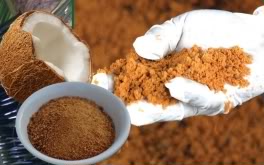
The process consists of six stages: selection of tree and mature inflorescence for tapping; collection of coconut sap; heat evaporation;conversion of sap syrup to coconut sap sugar; sieving and drying; and weighing and packaging.
Step 1. Selection of tree and mature inflorescence for tapping
1. Select bearing trees with healthy unopened inflorescence for tapping.
2. Bend the mature unopened inflorescence downwards for one week to allow the flow of the sap for tapping.
3. Tie the inflorescence with plastic twine and slowly pull them downwards.
4. Using a sharp knife, tap the inflorescence by slicing at least 6 mm to cut the tissues and eventually allow the surge of the sap. When the tip of the unopened coconut inflorescence is cut out, the sap slowly flows out.
Step 2. Collection of coconut sap
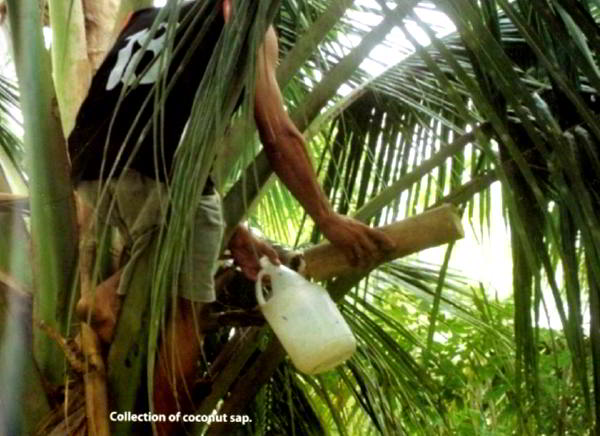
1. After slicing the unopened inflorescence, collect the liquid sap oozing out with the use of a plastic vessel. The collected sugar liquid has about 12–18% sugar content. Coconut sap is known to contain important amino acids, minerals, and vitamins.
2. To avoid the fermentation of the fresh sap, start its collection five hours after tapping. A total of 850 liters of sap ready for processing can produce 100 kilo of sugar.
Step 3: Heat evaporation
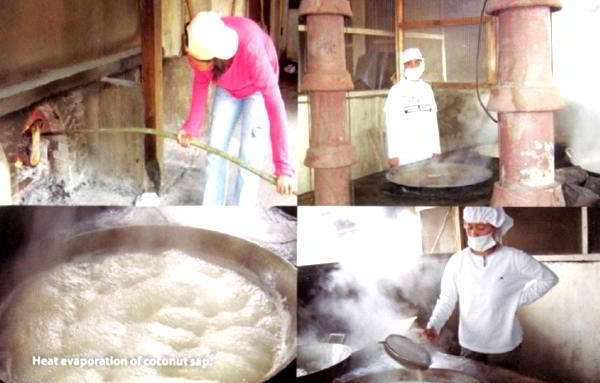
1. Boil the collected sap up to 115°C using a brick-fabricated oven locally known as “pugon.” The oven has improvised chimney where smoke will be emitted to ensure smoke- free smelling sugar.
2. When the liquid is already boiling, the scum will come out and this has to be removed to avoid the formation of dark residues on the final product.
3. The boiling of the sap will take about 3–4 hours to remove water, leaving the sugar content of the coconut sap.
Step 4: Conversion of sap syrup to coconut sap sugar
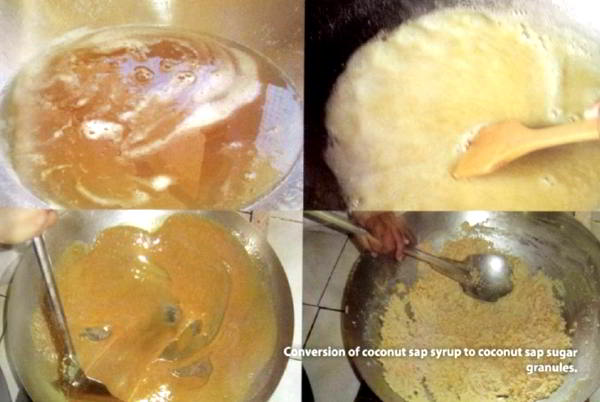
1. Transfer the liquid to food grade stainless wok when it turns into syrup.
2. Stir the syrup continuously to avoid burning and to ensure granulation. At this phase, the liquid will change into solid form, hence, temperature change is critical. Stirring allows air to enter the sticky syrup that will cause the gradual cooling resulting to granulation.
3. Remove wok from the fire and transfer it to a wooden trivet. Stir until the sugar granules are formed.
Step 5. Sieving and drying the coconut sap sugar
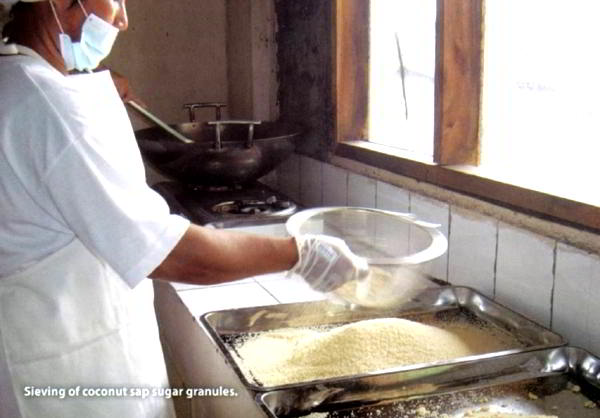
1. Let the sugar cool off and continue pressing to break the lump.
2. Sieve the sugar to have a uniform particle size to produce quality product.
3. Put the sugar granules in a food grade stainless tray and let dry for one hour to lessen the moisture content.
Step 6. Weighing and packaging
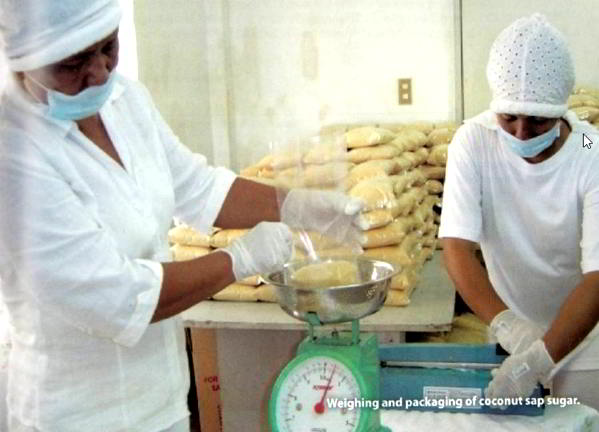
1. Collect the sugar in a big container and store overnight.
2. Weigh and pack the sugar using the commercially available transparent polyethylene plastic bag (.03 in x 8 in x 5 in).
Compared with refined cane sugar, coco sugar has a lower glycemic index (GI), which makes it suitable for use by health buffs and diabetics. Having a low GI means that people who consume coco sugar will not experience sudden spikes in their blood glucose or blood sugar levels.
Packed coco sugar is sold at P200 per kilo. With a production cost of P153.50, including labor, management, and packaging cost, students earn P46.50 per kilo.
Source: PCARRD. Profitability analysis: Coconut sap sugar production module. Los Baños, Laguna: PCARRD, DOST, 2010. PCARRD Farmnews, DOST, January–March 2011

can the trees still produce viable fruits if they are used for sugar production??
I think the ideal pH is 6, below is already acidic.
12% to 18% sugar content means sugar brix content what if the ph level of coco sap is 6 to 7 ph is it still ideal for making coco syrup or sugar?
if 12% to 18% sugar content meaning 850 liter sap it will produce 8 kg. plus coco sap sugar.